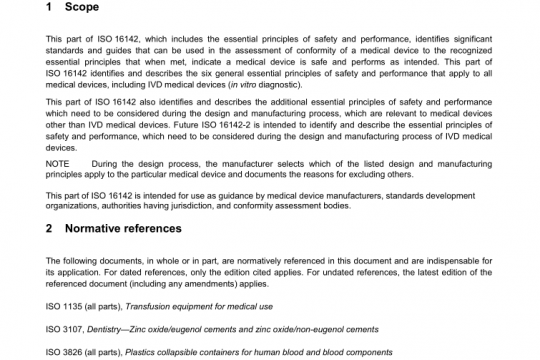AAMI TIR105 pdf free download
AAMI TIR105 pdf free download.Risk management guidance for combination products.
4.1.1 Description of combination product Careful consideration should be applied to determining the completeness and level of detail in describing the combination product and the inter-relationships of its constituent parts. A component of single-entity combination product may play more than one role, as is the case for a syringe prefilled with a drug, which, therefore, serves both as a container closure for the drug and as a delivery system. Also, details related to the patient population, user profile or operating principles may change and add more complexity to the product. Therefore, descriptions of design elements and external controls (e.g., instructions, warnings, user training, limits or alarms) should consider such complexities. 4.1.2 Necessary expertise The range of expertise needed to inform, and support risk management is necessarily different for a combination product than for a drug or device alone and should be considered in defining the roles and responsibilities of stakeholders, including the risk management team. 4.2 Understanding of relevant standards and guidance A basic understanding of the risk management process standards 5 ISO 14971 [38] and ICH Q9 [25] is important to effective planning of risk management activities for combination products. Although this TIR is intended to be used as a stand-alone reference document in supporting a marketing application and for maintaining safety of the product throughout its lifecycle, background knowledge of the key principles will be helpful. In addition, product-specific safety consensus standards and other applicable guidance are also important in planning the development of and risk management activities associated with the combination product. These product-specific standards can inform and support overall risk management activities for a combination product.4.3 Integration of information from third-party vendors An important consideration for manufacturers of combination products is how to assemble risk management files when using components supplied by third-party vendors. Many times, third-party vendors have developed risk assessments. The approach to integrating this information should be addressed in the combination product RMP. Integrating a supplier-provided risk assessment into an overall combination product risk assessment is essentially no different than integrating any potential component with use hazards into the overall assessment for a product. Component assessments from vendors should be reviewed to confirm whether they identify potential risks inherent to the use of the component, including–most importantly—an explanation of the relationship between the identified hazards and the impact on proper use of the component. It is important that the combination product assessment consider any potential hazards identified by suppliers and their relevance, as well as how the combination product will be used and any potential failures of the constituent part in the combination product that are not addressed in the supplier-provided assessment. Beyond consideration of failures, the combination product manufacturer should identify any interactions of the component with the finished product to address in the combination product risk assessment (see Section 5). Although they should ensure that the RMP and associated risk management process for their combination products are stand-alone and robust, manufacturers might find it helpful to establish a risk management file (RMF) that includes reference to documents held or developed by, for example, a design company or a contract manufacturer as well as suppliers of components and constituent parts, as a resource to leverage when developing and reviewing their risk management programs and when assessing and responding to safety signals.AAMI TIR105 pdf download.
Other IEC Standards
-

ANSI AAMI ISO 16142-1 pdf free download – non-IVD medical devices and guidance on the selection of standards
AAMI standards list DOWNLOAD -

ANSI AAMI ISO 16142-2 pdf free download – General essential principles and additional specifc essential principles
AAMI standards list DOWNLOAD


